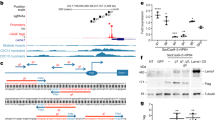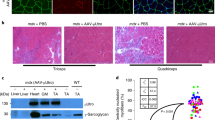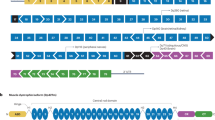Abstract
DUCHENNE muscular dystrophy (DMD) is a severe, progressive muscle-wasting disease that causes cardiac or respiratory failure1,2 and results in death at about 20 years of age. Replacement of the missing protein, dystrophin, using myoblast transfer in humans or viral/liposomal delivery in the mouse DMD model is inefficient and short-lived3,4. One alternative approach to treatment would be to upregulate the closely related protein, utrophin5,6, which might be able to compensate for the dystrophin deficiency in all relevant muscles7,8. As a first step to this approach, we have expressed a utrophin transgene at high levels in the dystrophin-deficient mdx mouse. Our results indicate that high expression of the utrophin transgene in skeletal and diaphragm muscle can markedly reduce the dystrophic pathology. These data suggest that systemic upregulation of utrophin in DMD patients may lead to the development of an effective treatment for this devastating disorder.
This is a preview of subscription content, access via your institution
Access options
Subscribe to this journal
Receive 51 print issues and online access
$199.00 per year
only $3.90 per issue
Buy this article
- Purchase on Springer Link
- Instant access to full article PDF
Prices may be subject to local taxes which are calculated during checkout
Similar content being viewed by others
References
Hoffman, E. P. Brain Pathol. 6, 49–61 (1996).
Emery, A. E. H. Duchenne Muscular Dystrophy (Oxford Monogr. Med. Genet. No. 24, Oxford Univ. Press, 1993).
Partridge, T. A. & Davies, K. E. Br. Med. Bull. 51, 123–137 (1995).
Morgan, J. E. Hum. Gene Ther. 5, 165–173 (1994).
Love, D. R. et al. Nature 339, 55–58 (1989).
Tinsley, J. M. et al. Nature 360, 591–393 (1992).
Tinsley, J. M. & Davies, K. E. Neuromuscul. Discord. 3, 537–539 (1993).
Hoffman, E. P. Nature Genet. 8, 311–312 (1994).
Phelps, S. F. et al. Hum. Mol. Genet. 4, 1251–1258 (1995).
Wells, D. J. et al. Hum. Mol. Genet. 4, 1245–1250 (1995).
Cox, G. A. et al. Nature 264, 725–729 (1993).
Tinsley, J. M., Blake, D. J., Zuellig, R. A. & Davies, K. E. Proc. Natl Acad. Sci.USA 91, 8307–8313 (1994).
Blake, D. J., Tinsley, J. M. & Davies, K. E. Brain Pathol. 6, 37–47 (1996).
Sicinski, P. et al. Science 244, 1578–1580 (1989).
Rafael, J. A. et al. Hum. Mol. Genet. 3, 1725–1733 (1994).
Matsumara, K. & Campbell, K. P. Muscle Nerve 17, 2–15 (1994).
Campbell, K. P. Cell 80, 675–679 (1995).
Stedman, H. H. et al. Nature 352, 536–539 (1991).
Collins, A. F. et al. Blood 85, 43–49 (1995).
Dover, G. J., Brusilow, S. & Charache, S. Blood 84, 339–343 (1994).
Brennan, K. J. & Hardeman, E. C. J. Biol. Chem. 268, 719–725 (1993).
Muscat, G. O. & Kedes, L. Mol. Cell. Biol. 7, 4089–4099 (1987).
Hogan, B., Constantini, F. & Lacey, E. Manipulating the Mouse Embryo: A Laboratory Manual (Cold Spring Harbour Lab. Press, New York, 1986).
Nhuyen, T. M. et al. J. Cell Biol. 115, 1695–1700 (1991).
Sherratt, T. G., Vulliamy, T. & Strong, P. N. Biochem. J. 287, 755–759 (1992).
Roberds, S. L., Anderson, R. D., Ibraghimov-Breskrovnaya, O. & Campbell, K. P. J. Biol. Chem. 268, 23739–23742 (1993).
Ibraghimov-Breskrovnaya, O. et al. Nature 355, 696–702 (1992).
Author information
Authors and Affiliations
Rights and permissions
About this article
Cite this article
Tinsley, J., Potter, A., Phelps, S. et al. Amelioration of the dystrophic phenotype of mdx mice using a truncated utrophin transgene. Nature 384, 349–353 (1996). https://doi.org/10.1038/384349a0
Received:
Accepted:
Issue Date:
DOI: https://doi.org/10.1038/384349a0
This article is cited by
-
Biomarkers for Duchenne muscular dystrophy progression: impact of age in the mdx tongue spared muscle
Skeletal Muscle (2023)
-
Pharmacological inhibition of HDAC6 improves muscle phenotypes in dystrophin-deficient mice by downregulating TGF-β via Smad3 acetylation
Nature Communications (2022)
-
Inactivation of Sirt6 ameliorates muscular dystrophy in mdx mice by releasing suppression of utrophin expression
Nature Communications (2022)
-
Duchenne muscular dystrophy cell culture models created by CRISPR/Cas9 gene editing and their application in drug screening
Scientific Reports (2021)
-
Identification of therapeutics that target eEF1A2 and upregulate utrophin A translation in dystrophic muscles
Nature Communications (2020)
Comments
By submitting a comment you agree to abide by our Terms and Community Guidelines. If you find something abusive or that does not comply with our terms or guidelines please flag it as inappropriate.



